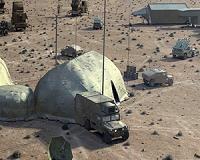| . |  |
. |
San Diego CA (SPX) Jan 05, 2011 Northrop Grumman has successfully completed the second flight test phase of the Multi-Role Tactical Common Data Link (MR-TCDL) system, which provides real-time networking connectivity to warfighters and commanders by enabling extremely fast exchange of data via ground, airborne and satellite networks. This series of 14 flight tests verified the MR-TCDL system's capabilities, marking a critical milestone toward completion of the MR-TCDL developmental testing program. For the flight tests, Northrop Grumman integrated MR-TCDL onto a Gulfstream II aircraft and a NASA ER-2 aircraft and digitally connected the aircraft to each other and to a series of ground entry points. The tests demonstrated the system's ability to reliably transmit data at rates greater than 200 megabits per second between multiple aircraft and ground networks as well as between aircraft at distances in excess of 270 nautical miles. This capability enables high-definition video teleconferencing and high-speed connection and extension of terrestrial wired and wireless networks access for senior leaders. Northrop Grumman is performing the tests under its MR-TCDL Developmental Test and Operational Test (DT/OT) program contract for the U.S. Army Communications-Electronics Research, Development and Engineering Center. The MR-TCDL system is built by L-3 Communications Systems-West, Salt Lake City. "Phase two testing has exceeded both our own and our customer's expectations," said Claude Hashem, Northrop Grumman vice president and deputy general manager of the company's Network Communications Systems business. "The team proved MR-TCDL is a terminal that will meet the true bandwidth requirements of all types of airborne ISR (intelligence, surveillance, and reconnaissance) and C2 (command and control) aircraft, and that it is a true joint aerial layered network capability providing the flexibility of satcom combined with very high-capacity line-of-sight connectivity. "Fielding of this unique capability introduces a paradigm-shaping ability to aircraft by combining multiple communications paths into one terminal. The result is timely, effective and diverse service to warfighters and decision-makers at a substantial cost savings," Hashem said. The company will fly the system in operationally relevant scenarios during the next test phase. Testing will connect the MR-TCDL equipped Gulfstream II, NASA ER-2 and operational aircraft with a series of ground entry points that connect to the Internet. In addition to L-3 Communications, members of the Northrop Grumman team include Alpha Research and Technologies Inc., Sacramento, Calif.; Orion Aviation Group, Phoenix; and the National Aeronautics and Space Administration, Houston. Work is performed in San Diego, Salt Lake City, Phoenix and Houston. The Defense Micro-Electronics Activity awarded the 30-month, $59 million MR-TCDL DT/OT contract to Northrop Grumman's Information Systems sector in January 2009.
Share This Article With Planet Earth
Related Links - Read the latest in Military Space Communications Technology at SpaceWar.com
 IBCS Completes Warfighter-Centered Design Exercises
IBCS Completes Warfighter-Centered Design ExercisesHuntsville AL (SPX) Dec 21, 2010 The U.S. Army and Northrop Grumman have completed a series of warfighter-centered design exercises for the Integrated Air and Missile Defense Battle Command System (IBCS). The exercises are part of the IBCS development plan that incorporates a disciplined focus on the needs and limitations of the soldier in order to improve and shorten decision and execution cycles when using the system. ... read more |
|
| The content herein, unless otherwise known to be public domain, are Copyright 1995-2010 - SpaceDaily. AFP and UPI Wire Stories are copyright Agence France-Presse and United Press International. ESA Portal Reports are copyright European Space Agency. All NASA sourced material is public domain. Additional copyrights may apply in whole or part to other bona fide parties. Advertising does not imply endorsement,agreement or approval of any opinions, statements or information provided by SpaceDaily on any Web page published or hosted by SpaceDaily. Privacy Statement |